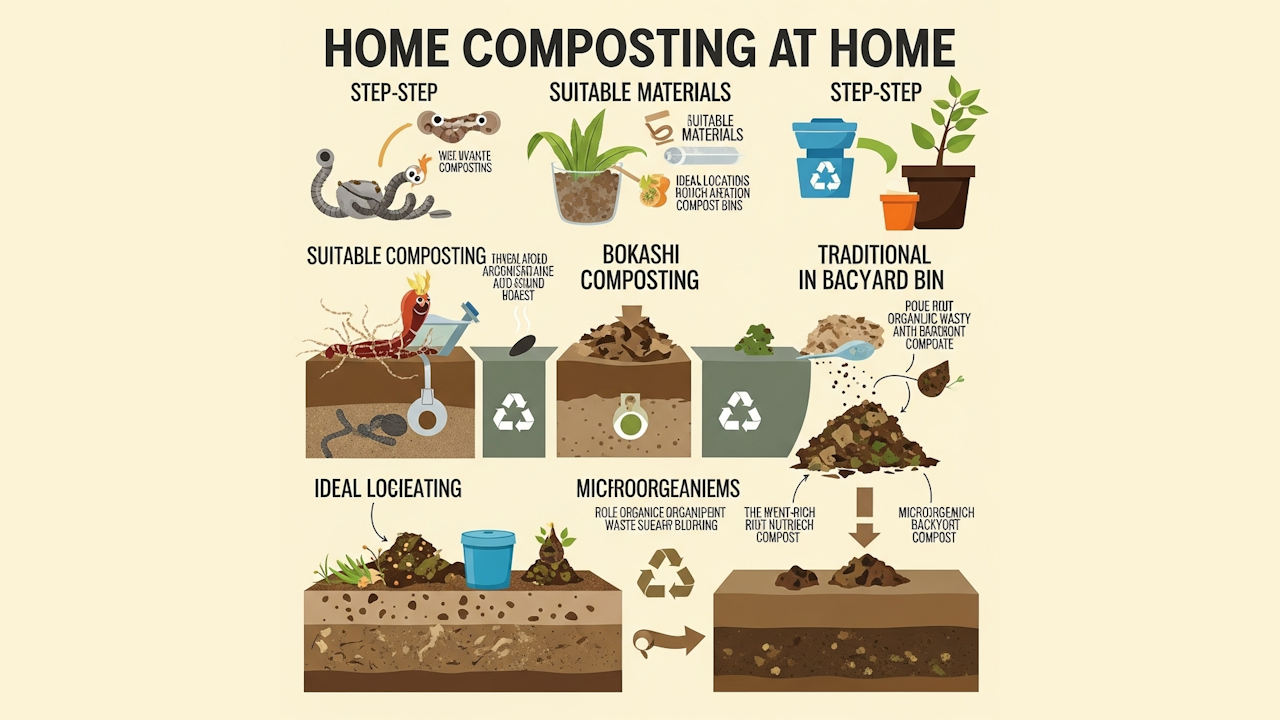Composting is an environmentally friendly and practical method of managing organic waste while enriching soil with vital nutrients. By transforming food scraps, garden clippings, and other biodegradable materials into nutrient-rich compost, individuals contribute to reducing landfill waste, lowering greenhouse gas emissions, and promoting sustainable living. Starting composting at home is not only simple but also immensely rewarding for anyone eager to adopt eco-conscious habits.
Understanding Composting Basics
Before diving into the logistics of setting up a composting system, it’s essential to understand what composting entails. Composting is a natural process where organic matter decomposes under the influence of microorganisms, oxygen, moisture, and temperature. The result is a dark, crumbly, and earthy-smelling material known as compost, often referred to as “black gold” for its ability to enrich soil and improve plant health.
A successful composting system balances two primary components: green and brown materials. Greens include nitrogen-rich items like vegetable peels, coffee grounds, and fresh grass clippings. Browns, on the other hand, are carbon-rich materials such as dried leaves, cardboard, and shredded paper. A good compost pile typically follows a ratio of two to three parts browns to one part greens, ensuring proper decomposition while avoiding unpleasant odors.
Choosing the Right Composting Method
There are various composting methods, each catering to different spaces, lifestyles, and levels of effort. Selecting the right approach is critical to initiating and maintaining a composting habit.
- Backyard Composting: Ideal for individuals with outdoor space, backyard composting involves creating a compost pile or using a bin. Materials are layered, turned periodically for aeration, and left to decompose over several months. This method is straightforward and accommodates a wide variety of organic waste, including garden trimmings and food scraps.
- Vermicomposting: Perfect for smaller spaces like apartments, vermicomposting uses worms, typically red wigglers, to break down organic matter. A worm bin can fit under a kitchen counter or on a balcony, making it accessible for urban dwellers. Worm castings, the byproduct of this process, are incredibly nutrient-dense and beneficial for plants.
- Bokashi Composting: Originating in Japan, bokashi composting is an anaerobic method that ferments organic waste using a special mix of microorganisms. It is compact, odorless, and capable of breaking down cooked food and dairy products, which are typically excluded from traditional composting.
- Tumbler Composting: Compost tumblers are enclosed bins mounted on a frame that can be rotated to mix materials easily. This method is efficient and speeds up decomposition, making it an attractive choice for those seeking quick results.
Setting Up Your Composting System
Starting a home composting system involves several practical steps. First, identify a location for your compost bin or pile. Outdoor systems benefit from being placed on bare soil to allow for natural drainage and microbial activity. For indoor systems, ensure adequate ventilation and a location away from direct sunlight to prevent overheating.
Next, assemble materials for composting. Avoid adding items like meat, fish, and oily foods unless using a bokashi system, as these can attract pests and create foul odors. Begin layering greens and browns in the chosen bin, ensuring sufficient aeration by mixing the pile regularly. Moisture levels should resemble a wrung-out sponge—neither too wet nor too dry.
Investing in tools such as a compost thermometer and aerator can simplify the process and ensure optimal conditions. Compost thermometers help monitor the internal temperature of the pile, which should ideally range between 135°F and 160°F to promote microbial activity. Aerators facilitate the mixing process, ensuring even decomposition.
Overcoming Common Challenges
While composting is relatively straightforward, it can present challenges that require attention. One common issue is foul odors, often caused by an imbalance of greens and browns or excessive moisture. Adjusting the ratio and adding dry materials like shredded newspaper can address this problem effectively.
Pest management is another consideration. To deter rodents and insects, ensure food scraps are buried under a layer of browns and avoid adding prohibited items. Using enclosed bins or composting systems with tight-fitting lids can also minimize pest activity.
Slow decomposition is a frequent concern, often due to insufficient aeration or incorrect moisture levels. Turning the pile more frequently and maintaining proper moisture can accelerate the process. Additionally, chopping or shredding materials into smaller pieces increases surface area for microorganisms, promoting faster breakdown.
Benefits of Home Composting
The rewards of home composting extend far beyond waste management. Compost enriches soil structure, enhances its ability to retain moisture, and provides a natural alternative to chemical fertilizers. Gardens, flower beds, and even indoor plants thrive when supplemented with homemade compost.
Environmental benefits are equally significant. Composting reduces the volume of organic waste sent to landfills, where it would otherwise produce methane—a potent greenhouse gas. By composting, households play a direct role in mitigating climate change and conserving resources.
Moreover, engaging in composting fosters a deeper connection with nature and an appreciation for sustainable practices. It serves as an educational opportunity for families, teaching children the importance of reducing waste and understanding ecological cycles.
Making Composting a Habit
For composting to become a long-term practice, it’s essential to integrate it into daily routines. Placing a countertop compost bin in the kitchen simplifies the collection of food scraps and minimizes the effort required. Developing a schedule for turning the pile or maintaining the bin ensures consistency and prevents neglect.
Community involvement can further motivate individuals to sustain composting habits. Participating in local composting programs or exchanging tips with neighbors fosters a sense of shared responsibility and encouragement. Additionally, exploring creative uses for finished compost, such as creating a herb garden or donating it to community gardens, can reinforce the value of this practice.
Embracing a Greener Lifestyle
Initiating composting practices at home is a powerful step toward adopting a greener, more sustainable lifestyle. By diverting organic waste from landfills and creating nutrient-rich soil amendments, individuals contribute to a healthier planet while reaping the rewards of vibrant gardens and reduced waste. Regardless of space or experience, anyone can begin composting and take pride in making a positive environmental impact.

